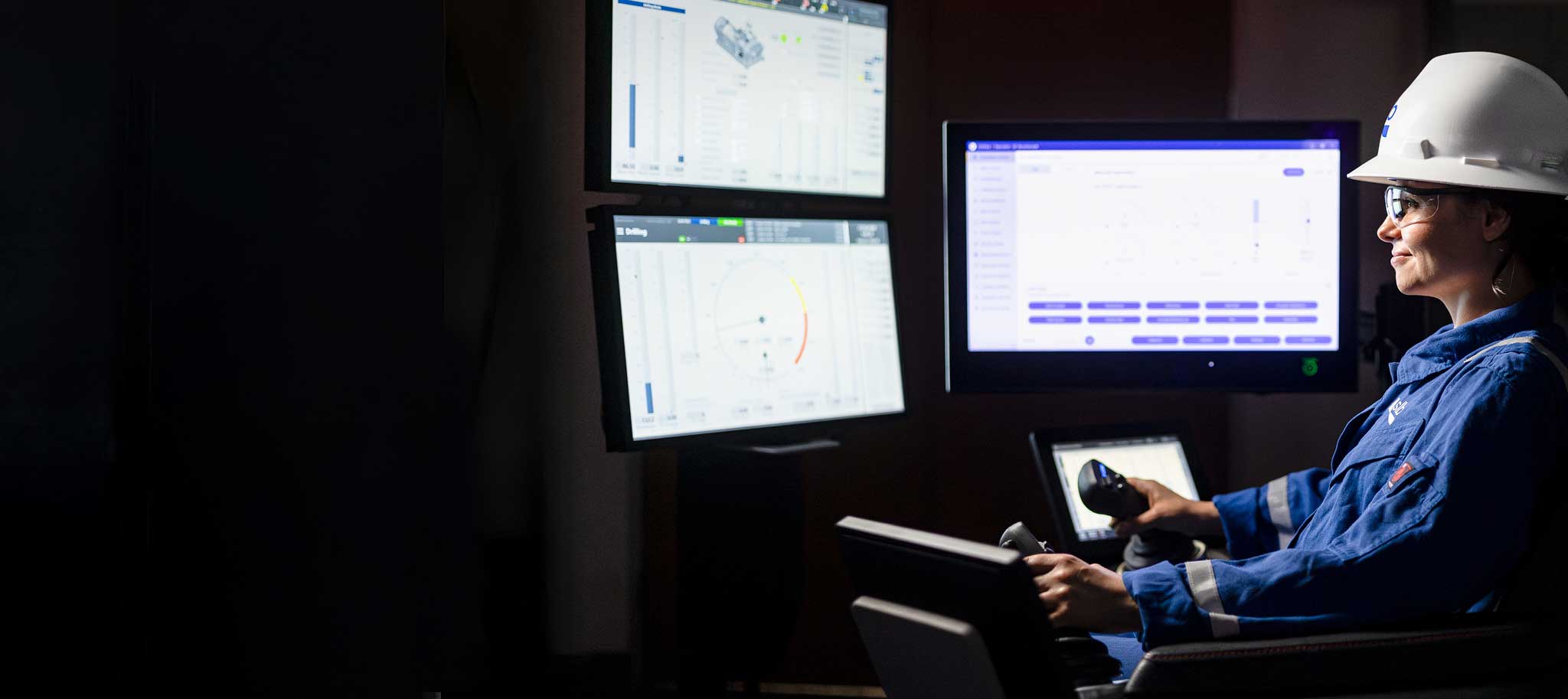In this article
Use the main characteristics of a digitally transformed oil and gas operator as a checklist for reimagining your own approach:
- An organization not just collecting data but led by it.
- Day-to-day operations that are as remote as they are automated.
- A nimble and democratized organizational structure.
- A digital infrastructure integrated with extensibility and interoperability.
- Digital and information officers overlooking the entire system.
- Rapid and coherent measurement, especially where standardization is not possible.
- Agreements based on solutions rather than equipment.
An ever-increasing demand for its products, limited substitutions, and a high barrier to entry has been a formula for success that our industry has enjoyed over the last seven decades. In fact, we’re in an industry that hasn’t faced any major threats since the “peak oil” theory was proven wrong in 2009. The real question is how will the industry react under the long-term outlook of “peak demand”?
Oil and gas will continue to play a significant role in global energy production regardless of the speed or magnitude of an energy transition. That same transition, however, will also reorder the competitive landscape—meaning that global demand for oil and gas will change.
While many operators recognize this challenge, most still rely on their traditional way of doing things. Meantime, those operators that demand control of their future position in global energy production are forging ahead into new territory by digitally transforming their operations at a time that still feels relatively comfortable. They’ve recognized that, while traditional approaches served the industry well for many decades, the chance to reimagine how they do things is not something to be taken lightly.
What’s riskier than digitally transforming? Not digitally transforming.
While incremental improvements in efficiency—the kind due to tech, training, or process—have always improved the industry, a digital transformation represents the chance to holistically link what was previously isolated or, as I like to say, exchange the familiarity of our silos for the power of interoperability. A chance to reconfigure our operational structures in ways that render them more efficient, more productive, and safer for both people and the planet.
It’s a change, and change presumes risk. But I have yet to find an industry leader that won’t accept a certain level of temporary interruptions or internal pushback to avoid being left behind. After all, it's in everyone’s interest to choose the path that’s most conducive to sustainable growth.
There’s beauty in taking such a risk. Those who leap toward fully connecting and automating their operations will be the ones to lead the global landscape into the future. Why? Because digital transformation is a paradigm shift—a vertical leap onto a whole new plane. Rather than opting for different combinations of previously existing pieces, these forward-thinking players are the ones altering the entire gameboard.
The checklist for digitally transformed oil and gas operators
A digitally transformed operator seeks ruthless efficiency. It leverages advancements in downhole compute, Internet of Things (IOT), connectivity, edge compute, hyperscaler cloud, ubiquitous bandwidth, and artificial intelligence to connect its operations, thereby eliminating (now superfluous) decision making with real-time intelligence and automation.
These operators leverage modern tech to drive the next step change in operational performance and efficiency. They're not just digitizing; they’re becoming fundamentally digital. It’s an approach that’s tangibly different from that of a traditional operator across all dimensions, and this is how.
An organization not just collecting data but led by it.
The common misconception is that digitizing equates to being digitally transformed, but shifting from analog to digital is just the beginning. That’s not to say that data, analytics, and data mining aren’t important; they're essential, in fact, given that a consistent data story is the differentiator of the future. This is why being data-driven remains the first checkpoint for a digitally mature organization.
Digital transformation means being data-driven, not just data-focused.
Operators have focused on data during their planning phases for many decades. Large investments in subsurface, pipeline, or facility models require data acquisition, data manipulation, and risk analysis that often take months or years to complete. What’s currently missing in our industry is a focus on using data in the execution of ongoing operations.
When planning a new well, for example, operators collect and analyze subsurface data to identify the best wellbore trajectory and minimize risk. The question is, how are they using data to ensure that well is executed not only according to plan, but also according to optimal efficiency?
Reaching optimal efficiency means eliminating all waste within a defined risk envelope, and it requires two major evolutions when it comes to data: time and trust. Let’s discuss time first.
Modern operators need analysis to be done in seconds (not weeks or months) to properly utilize data in the operational window. Operations are complex and answers must be instant, meaning their time from data acquisition to decision is a fraction of that compared to the planning phase. For this, industry players can be seen adopting the latest in downhole, edge, and cloud tech to achieve optimal efficiency.
Second is trust. Today's operational decisions are often based on human experience first and then verified later through a data-driven approach. Errors are very costly, and large investments are made to retain the people with the most experience. As operators extend their data-driven mindset to the execution phase, human experience will be enhanced by real-time intelligence. Decisions will be made by machines with limited human intervention, which marks a dramatic shift in how much humans trust their digital systems—and one that’s integral to achieving optimal efficiency.
Day-to-day operations that are as remote as they are automated.
For better or worse, oil and gas are not found in cities. They're often found in hard-to-reach corners of the globe, which is why connectivity is becoming standard for all operations. Once connected, operators need to invest in crossing the barriers of “time” and “trust” to reach the next step of intelligence. Intelligence requires the right algorithms collaborating in the right ways with the right humans. This seamless interaction will not only monitor but also control all operations remotely.
Beyond connectivity and intelligence, you have the holy grail: autonomous systems. These systems require more investment because machines need to interact with each other in an ever-changing environment. That said, the benefits are so significant that it’s hard to even describe the impact.
We must realize that individuals perform uniquely–each with their own positive attributes and learned behavior–but they don’t perform optimally. Our industry needs autonomous operations to achieve optimal efficiency. Autonomous operations move all decisions and actions from the human to the machine, leaving the human to monitor the system instead of the process.
Digitally transformed operators completely embrace this concept. Connected, intelligent, and autonomous operations are foundational to the way they operate. They execute a job in the Congo one day, in the North Sea another, all from the same operations center. They know that if all their experts are in the same place, then that expertise is utilized to the maximum.
Both data and experience from around the world are immediately available, rendering decision making not just faster but also wiser.
And before you question the difficulty of making such decisions based solely on data, ask yourself: Do I use my car's built-in camera to park? I do. And do I feel I can trust it without looking in the mirror myself? Yes. That’s exactly how digitally transformed operators feel, but on a larger scale. They know that the connectivity they've built, combined with the intelligence delivered to their experts in real time, is as dependable and secure as a Ford.
A nimble and democratized organizational structure.
Rather than viewing their operations as a collection of discrete silos that compete for capital, expertise, and resources, digitally transformed operators focus on agile processes and democratized knowledge. The former refers to their undying interest in improving the quality of their results by leveraging advanced tech that makes their workflows and processes faster and cleaner.
Democratized knowledge, on the other hand, refers to an operator’s ability to shift their employees’ mindsets toward partnering with the digital tech itself. “Skillsets” no longer refer to specific tasks within unique, physical environments, but rather an employee’s ability to comprehend and act upon the data they receive.
For the first time in our industry, width will be more important than depth.
Operators are now hiring based on broader skillsets, rather than someone’s deep knowledge of a narrow subject. They have machines for the deeper parts of the job, while people are hired to manage various cross-sections of the process. Why? Because while a person can’t do multiple tasks at a time, they can monitor them.
This combination of agility, access to knowledge, and mindset is what allows digitally transformed operators to embrace a horizontal structure built on collaboration between multiple functions. It’s also what enables employees to focus on innovation and real-time decision making rather than hands-on operation and micromanagement.
Combine that with the undeniable increase in safety that this new human-to-machine balance provides, and you have yourself a much more efficient operator.
A digital infrastructure integrated with extensibility and interoperability.
Modern operators understand that digital only works if it’s connected; otherwise, a piece of software is just a product. So, they ask themselves early, have we truly transformed the way we operate? They focus on building a digital layer that runs across all processes, rather than catering to individual groups in silos, because they know the power of modern tech cannot be harnessed without the right ecosystem housing them.
In other words, these operators boast a robust, dynamic, and fully integrated tech stack. They leverage cloud and edge computing, Internet of Things sensors, artificial intelligence and machine learning models, digital twins, blockchain for secure transactional processes, and advanced cybersecurity—all in one. An advanced level of integration becomes their main objective, knowing that it indirectly improves every other metric on their list. This, in turn, lightens the decision between retrofitting products and jumping into totally new systems given that their goal is much larger.
Digitally transformed operators see both the trees and the forest, understanding clearly how actions in one corner of their ecosystem ripple through the rest.
With the right stack focused on extensibility and interoperability, every piece of data collected can be used upstream or downstream to improve the next operation. Production data can be used to improve the performance of an electric submersible pump and the drilling of the next well. Drilling data can be used to drive completion decisions and facility planning. Liberating data to all parts of the organization becomes the battle cry of the organization.
Digital and information officers overlooking the whole system.
Above that integration layer, there’s a final layer of overarching processes managed by digital and information officers and their teams. They guard, analyze, and improve their ecosystems day in and day out.
How? With dynamic benchmarks and state-of-the-art performance tracking. Advanced analytics and dashboards provide them with a holistic view of performance across financial, operational, and environmental, social, and governance dimensions. All thanks to the crucial indicators such as equipment health, efficiency, and safety metrics tracked in real-time in the substrates below.
For this, awareness of what their service providers are doing is of top importance to these operators. Not just awareness, but knowledge. They understand the process, how the algorithms work, and what’s being done by humans versus machines. They gather the know-how and understand the model’s software well enough to contribute to its continued expansion.
This implies integrating everything from all providers into one layer—something digitally transformed operators demand.
Walls are brought down in a secure way, be it through the sharing of anonymous subsurface data or project-specific data (even financial) that can help partners adjust their pieces of the puzzle to best serve the objectives at hand. And operators leverage that trust to build bigger partnerships that ultimately run entire facilities or fields.
Collaboration, as always, is key.
Rapid and coherent measurement, especially where standardization is not possible.
With the likes of high-frequency indicators (e.g., sensors) and low-frequency indicators, such as legacy milestones, it's long been clear that digital transformation can be measured. What operators can now also do is standardize its deployment around the world—all thanks to a revamped way of measuring progress.
A digitally transformed operator doesn’t assess success simply by how many wells they’ve finished in a year. They have key performance indicators adapted to a larger scale, so they can properly assess the impact of future investments across a wider set of activities (even globally).
A simple example is rollout time. When an operator rolls out new software in 5 days compared to the historical 2 years, that’s a good sign of digital transformation. A 45-day task done perfectly in 3 days is another good sign, as is interpretation done in minutes instead of months. Thinking this way is as much a mindset shift as it is a documented one, and successfully managing that change is what allows an operator’s divisions, managers, and partners to all learn the same new language.
Rollout time is a tangible metric, but modern operators assign value to previously intangible measurements, as well. They’re just as interested in making their workflows savvier as they are in improving production, regularly answering questions such as:
- What did we do differently that brought results?
- How well do we monitor our processes?
- How did our workflow efficiency improve?
- How much cost were we able to offload?
- How much loss did we sustain and in which categories?
- How much asset recovery did we witness?
- How much real-time decision making did we achieve?
And, most importantly, what is our invisible lost time? They don’t claim 100% operating efficiency without first assessing whether some of their processes could have been done faster—in which case there’s still room for improvement.
Agreements based on solutions rather than equipment.
As you can imagine, all the characteristics mentioned so far describe an operator that sees contractual performance and success differently. This, in turn, calls for reimagining how operators build their legal agreements. Their relationships with providers are stronger, shifting from only delivering hardware to deploying software and solutions. The mindset is one of systemwide enhancements.
That means that even a piece of hardware is seen as another software piece in an operator’s consistent search for increased efficiency.
This is important because purchase decisions made in one department, say drilling, can significantly impact the results in another department, such as production. Operators’ goals and objectives have changed, with more focus placed on opex (e.g., production, well maintenance) than on capex.
Speaking of objectives, digitally transformed operators also weigh production optimization against long-term goals like carbon footprint reduction and environmental, social, and governance initiatives, all while prioritizing innovation, customer-centricity, and sustainability to remain competitive. They’re interested in how providers play a role in that entire process—in maintaining that ultimate balance rather than just the one on today’s balance sheet.
If everything’s so clear, why don’t we see more progress?
Every transformation requires change management, and change management requires an organization-wide alignment of values. When it comes to digitally transforming oil and gas, the essential values remain:
- Digital literacy—Providing education about modern tools, how they work, and what that means for the future to everyone.
- Absorption capacity—A relentless pursuit of utilizing the latest digital capabilities.
- Strong attitude—Not just the willingness to change, but also the capability to manage that change internally.
- Long-term vision—The desire to lead the change externally.
Finally, transformation requires openness. An openness that allows our industry to focus on balancing this new normal rather than over-assessing how we got here. An openness that brings us together to tackle the challenges we face collectively and correctly.
The good news is that our domain knowledge and experience are converging into today’s tech. This is the culmination of the ideal future that we, as an industry, built. We’ve been guiding innovation and imbuing it with our expertise for decades, to the point that we can now fully delegate many of our tasks (and dangerous tasks at that). Only then will our engineers have the headspace necessary to focus on pioneering what’s next.
This isn’t about any single operator—it’s about partnering to affect global change. And while progress at this level may be difficult, every challenge we’ve faced thus far has prepared us for this moment. It isn’t a one-size-fits-all, drag and drop solution, and tech maturity and complexity will matter just as much as they always have. But there’s a version of this transformation that suits each operator’s needs, and every step will lead to bigger ones in the right direction.
At the intersection of opportunity and the status quo, digital transformation is a promising path forward.
Our industry stands at a crossroads where the challenges of cost, efficiency, and environmental sustainability beckon change. Those who prioritize innovation and select the right partners will not only secure their place in the future energy landscape but also play a crucial role in shaping a more resilient global economy. The path forward requires bold vision and steadfast action, and the rewards are well worth the journey.



